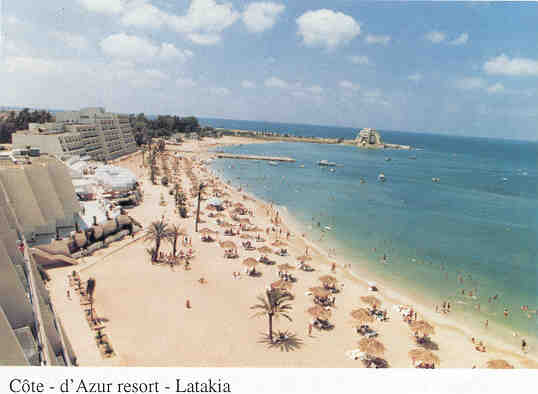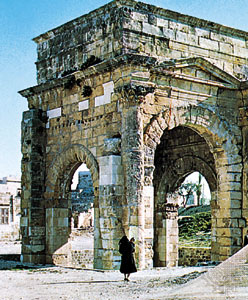
Latakia is Syria’s main
sea-port on the Mediterranean (186 km southwest of Aleppo). It has
retained its importance since ancient times. Latakia was one of the five
cities built by Saluqos Nikator in the second century B.C. He named it
after his mother, Laudetia. Not many ancient remains have survived in Latakia, but there are
four columns and a Roman arch from the time of Septimus Severus ( circa
200 A.D.), in addition to a beautiful Ottoman construction called “Khan
al-Dukhan”, which is now a museum.
Latakia
is the sea-gate to Syria. It is well-provided with accommodation, and is
well-placed as a base from which to explore the coastal regions of the
country. There are beaches, mountains, archaeological sites and many relics of the
Crusaders, all within a few hours from each other. It has the best accommodation along the whole coast.
Indeed, for the Tenth Mediterranean Games held in Latakiafrom
11 to 25 September 1987, Latakia benefited not only from the new infrastructures built to host the different
sporting events, but also from the building of new hotels like, for example
, the Cote d'Azur and Le Meridien Hotel Latakia. Built ten kilometers from the town center, these hotels complex
provide both first class comfort and private beaches where visitors can
practice all kind of water sports. L
atakia is one of the lungs of Syria. Most of her imports and exports pass through Latakia, which is also the end of the
overland route from Europe through Turkey.
It is only natural therefore that the Syrian government has taken particular care to develop the city.
Furthermore, Latakia is a perfect base for excursions throughout Syria's coastal regions where beaches, mountains,
lush countryside, archaeological sites and traces
of the Crusaders all lie within a short distance. In the city itself there is a pleasant walk along the corniche and the
adjacent colorfully planted avenues; it is
tempting to longer longer in the magnificent public gardens, right by sea, with their fine palm trees and clumps of
oleanders. There are not many ancient remains: four
columns and a Roman arch, in Sulibah, from the time of Septimus Severus (circa 200 A.D.), a triumphal arch on four
massive supports at the bottom of an avenue in the
south of the city and a regional museum recently installed in the ancient Khan al Dukhan monument.


Mention should also be made of the historically important Ras Shamra, only 16 km to the north of Latakia. This is the site of Ugarit, the kingdom that had a golden past in administration, education diplomacy, law, religion and economics between the 16th and the 13th centuries B.C. It is the kingdom that gave humanity the first alphabet in the world. This alphabet is still preserved in a clay tablet at the National Museum in Damascus. Documents, statues and jewels from the Ugarit Kingdom are also on display at the Latakia, Aleppo and Tartus museums.
